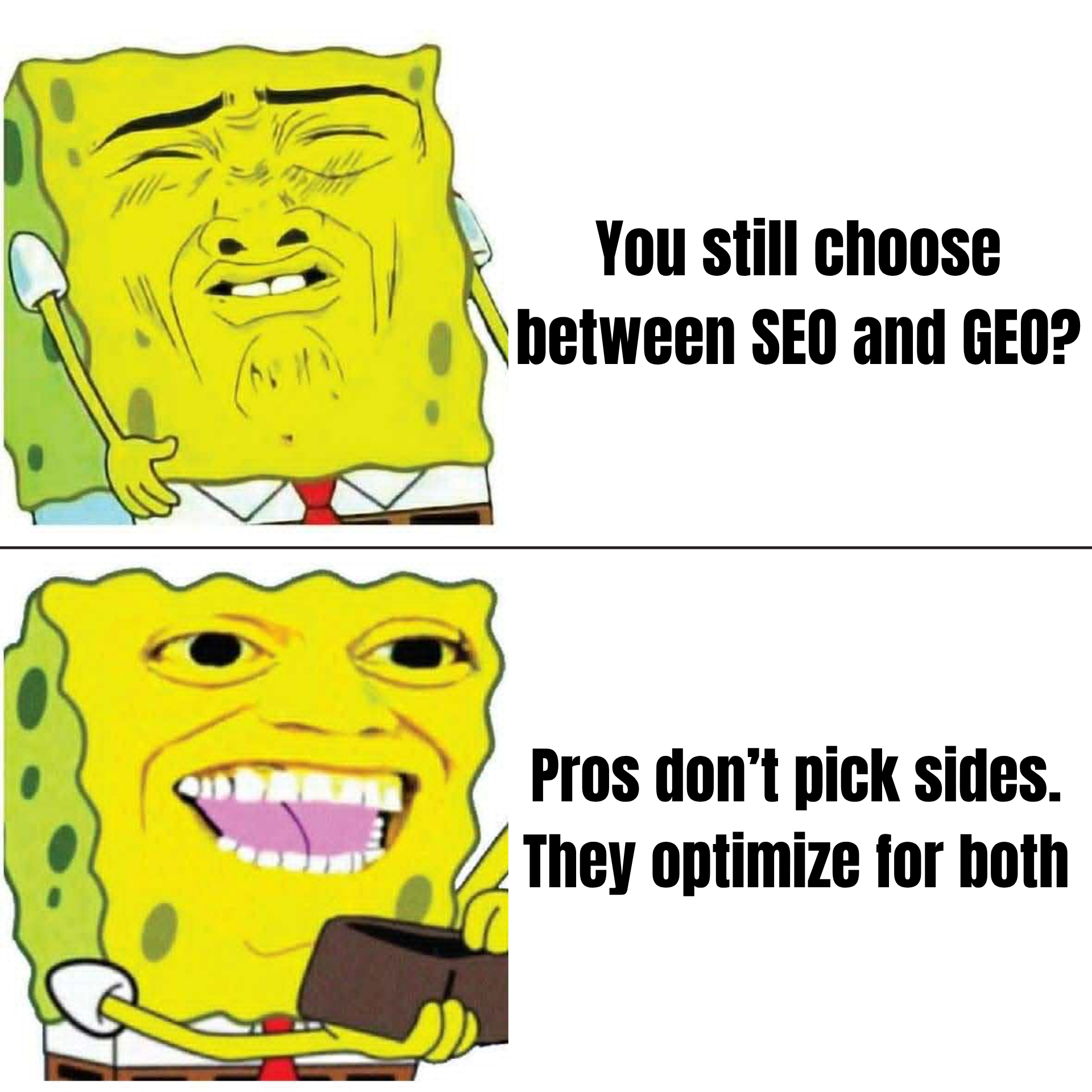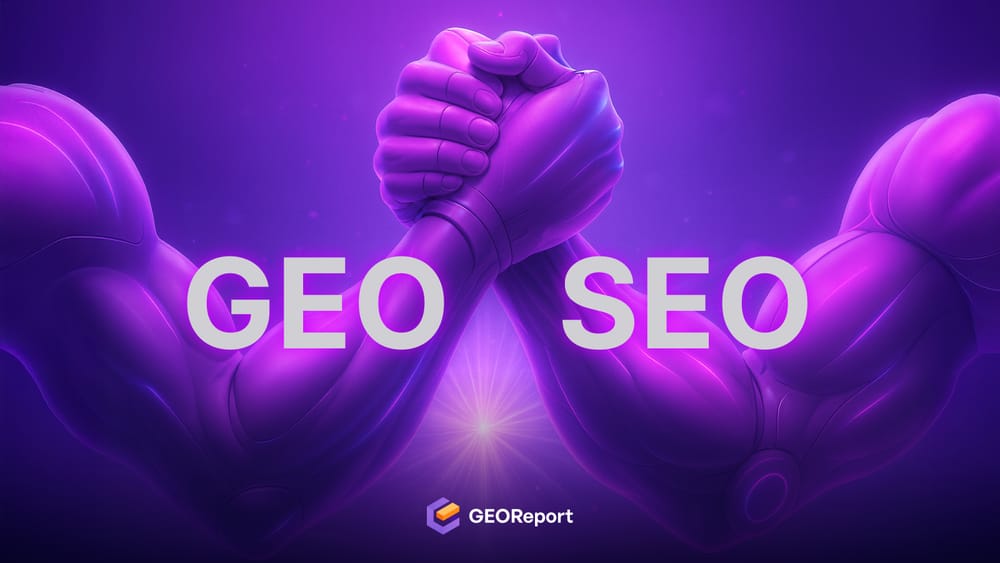SEO helps your brand get found, but Generative Engine Optimization (GEO) helps your brand get trusted. Search engines index and rank content. Generative engines, like ChatGPT or Gemini, read it, reason with it, and decide whether it deserves to be reused.
To win in both Google and AI search, your content must not only attract attention but also earn reasoning weight. When SEO provides structure and GEO adds depth, your brand achieves lasting visibility in both clicks and citations.
Why You Need Both SEO and Generative Engine Optimization
SEO is still essential, but it is no longer enough. The web is now split into two ecosystems: the search layer (where people find you) and the reasoning layer (where AI interprets you). If your brand only lives in one, it will slowly fade from the other.

Search Gets You Found, GEO Gets You Trusted
Search engines help users discover your pages. Generative search engines help users understand your value.
- SEO = discoverability. It ensures your website ranks for queries, collects backlinks, and earns organic traffic.
- GEO = interpretability. It ensures your brand appears in AI answers, summaries, and reasoning flows.
When both work together, you don’t just show up, you show up for the right reasons.
Visibility without reasoning depth leads to short-term clicks but long-term invisibility in AI systems.
From Search Results to AI Answers
Generative engines do not show “ten blue links.” They synthesize knowledge into context. To be included, your content must demonstrate reasoning value.
For example:
- In Google, a post about “best project management tools” ranks through backlinks and keyword relevance.
- In ChatGPT, the same topic appears only if your content explains why certain tools are effective with logic, comparison, or data.
Your job is to make your pages useful for both: structured for ranking, reasoned for reuse.
Rank High, Reason Deep
Ranking brings exposure. Reasoning brings endurance. If your page ranks today but lacks logic or credibility, AI may skip you tomorrow. Generative search visibility is built on long-term trust signals:
- Consistent schema.
- Verified data.
- Factual explanations that AI can verify.
Where SEO and GEO Work Together
SEO and GEO overlap more than most marketers think. They both reward structure, clarity, and quality signals. The difference lies in how these signals are used.
Shared Structure and Schema
Both systems depend on organization. To optimize for both:
- Use clear heading hierarchy (H1 → H2 → H3).
- Add structured schema (
Article,FAQPage,HowTo). - Keep entity names consistent across all content (company name, product lines, authors).
Search crawlers use structure to rank. AI engines use it to reason — the cleaner your structure, the easier it is to extract meaning.
From Keywords to Context
SEO works by matching words. Generative Engine Optimization works by interpreting meaning. If your content repeats “best AI tools for marketing” five times, Google may rank it but AI will compress it away as noise.
To optimize for context:
- Use keywords naturally inside explanations.
- Introduce cause and effect (e.g., “AI tools increase ROI because they automate data analysis”).
- Expand ideas using variations and examples.
This improves both semantic diversity (for AI) and relevance signals (for search).
Building Trust Both Ways
Trust sits at the heart of both systems.
- SEO Trust: E-E-A-T (Expertise, Experience, Authority, Trustworthiness).
- GEO Trust: ECS (Entity Confidence Stability) — the measure of how consistently AI models understand your brand meaning.
You build both by:
- Keeping tone, claims, and data consistent across content.
- Using citations and factual anchors.
- Avoiding exaggerated marketing copy that AI models flag as unreliable.
The Framework to Combine SEO and GEO
To align SEO and GEO, treat content as a dual system: SEO builds the frame. GEO fills it with reasoning. Follow these five steps.
Step 1: Write for Humans and Machines
Your content must be clear enough for humans to enjoy and structured enough for machines to interpret.
Practical tips:
- Keep sentences concise, 20–25 words max.
- Add metadata, alt text, and schema.
- Use short paragraphs (2–4 lines).
- Summarize complex sections into bullet points that AI can extract easily.
When people read smoothly and AI parses clearly, your page becomes visible in both systems.
Step 2: Focus on Reasoning, Not Repetition
Keyword stuffing belongs to the old web. Now, reasoning density beats keyword density. Each section should follow a mini-logic loop:
- Claim: What are you stating?
- Evidence: What backs it up (data, quote, case, example)?
- Impact: Why should it matter to the user or system?
Example: “AI tools improve email performance by analyzing tone and engagement data, allowing brands to personalize subject lines and timing. That’s why AI-driven campaigns see 20% higher open rates.”
This single paragraph satisfies both SEO (keyword, clarity) and Generative Engine Optimization (reasoning chain).
Step 3: Link Pages by Logic, Not Just Anchor Text
Internal linking now acts as reasoning glue. Do this:
- Connect blog posts that form a logical journey (e.g., “GEO Metrics” → “GEO Trust Framework”).
- Use anchor phrases that explain why the link matters.
- Keep each link contextually relevant; AI treats irrelevant ones as noise.
A network of logically linked content helps AI map your website as one coherent reasoning source.
Step 4: Add Evidence and Schema to Build Credibility
AI favors facts, not fluff. To build credibility:
- Include data from trusted reports (Princeton, Gartner, Statista).
- Use schema to label your sources and references.
- Mark definitions and results using JSON-LD so AI can interpret relationships.
Every proof strengthens your inclusion in reasoning chains and raises your VDI (Visibility Depth Index) score.
Step 5: Track SEO and GEO Metrics Together
Measuring both systems shows how balanced your visibility really is.
| Metric | System | Purpose |
|---|---|---|
| CTR, Rankings | SEO | Show how visible you are in search results |
| VDI (Visibility Depth Index) | GEO | Measure inclusion depth in AI reasoning |
| RDR (Reasoning Depth Ratio) | GEO | Track frequency of use in AI answers |
| ECS (Entity Confidence Stability) | GEO | Show how stable your brand trust remains |
If your SEO is strong but GEO metrics are low, your brand is being found but not used.
Case Study: HubSpot’s Dual Optimization
HubSpot integrates SEO and GEO better than most. Their content ranks high in Google and appears inside AI-generated summaries.

How their blog balances ranking and reasoning
- Uses SEO-friendly headers and metadata.
- Includes reasoning sections like “Why it matters” and “How it works”.
- Keeps tone factual and readable for humans and models alike.
This ensures every HubSpot post can be both ranked and reasoned with.
What GEO Metrics Reveal Beyond SEO Data
HubSpot’s GEOReport audit shows:
- High VDI: AI uses HubSpot content in multiple reasoning scenarios.
- High ECS: The brand’s meaning remains consistent across models.
Their success shows how structure plus reasoning equals durable authority.
How to Measure Visibility Across Search and AI
Visibility is no longer about where you rank, but also where you reason. Use both SEO and GEO tools to see the full picture.
SEO Tools: Ranking Layer
- Google Search Console for impressions, CTR, and keyword ranking.
- Ahrefs or SEMrush for backlinks and authority tracking.
GEO Tools: Reasoning Layer
- GEOReport.ai for inclusion depth, trust metrics, and AI citation tracking.
- Metrics to monitor:
- VDI: Depth of reasoning inclusion.
- RDR: Frequency of logical reuse.
- ECS: Stability of meaning across generative engines.
Combine Insights
Overlay SEO and GEO data monthly to see:
- Which pages bring traffic but lack AI inclusion.
- Which articles perform strongly in reasoning but need SEO structure.
This dual visibility analysis becomes your True Visibility Score.
The Visibility Flywheel
When SEO and GEO reinforce each other, visibility becomes self-sustaining.
- SEO builds reach: Search engines bring new visitors.
- GEO builds trust: AI engines reuse your reasoning and reward factual precision.
- AI mentions boost credibility: Generative inclusion signals expertise back to users.
- Trust improves SEO again: More engagement, backlinks, and AI citations raise organic ranking.
This loop turns every article into an authority-building asset.
Ranking is temporary. Reasoning is compounding.
Editor’s Note: Visibility Means Nothing Without Understanding
In the new internet, being seen is not enough. You must also be understood. SEO ensures discovery, but GEO ensures meaning. The strongest brands in the AI era will not just rank high, they will reason deeply.

